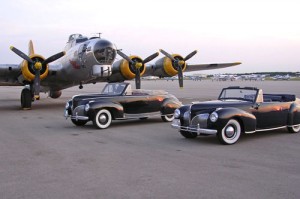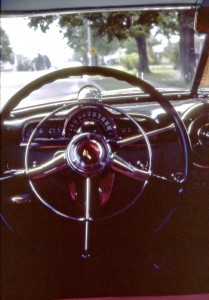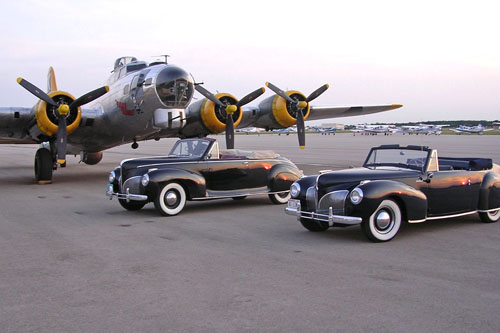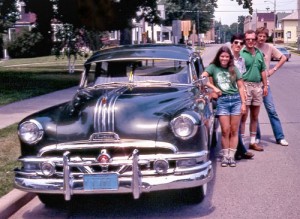
The vintage B-17, Elmer Fudd, makes a great backdrop for Doc’s 1941 Lincoln Zephyr (center) and a friend’s 1941 Lincoln Continental.
By Greg Brown
“Super Snipe?” Old Doc had to be kidding. Sure, some birds carry the name “snipe,” but like most former Boy Scouts, I remembered only the pain of being duped into a ritual “snipe hunt” on my first troop campout. (Future scouts, avert your eyes to preserve your coming initiation.)
When Jean and I first married, her grandparents lived in tiny Juneau, Wis. We flew there from Indiana by Cessna 172 to visit them as often as our newlyweds’ budget would allow. Our usual mission was to hang out with family, but once a year we’d bundle into Grandpa’s car for a multigenerational road trip to “the Oshkosh fly-in.”
Thanks to Gramps and Granny’s next-door neighbors, “Doc” and Marge, I soon joined another annual excursion. Over the years, Doc, a large-animal veterinarian, had liberated numerous collectible cars from dusty corners of his patients’ barns. Among them was a sporty 1939 Ford business coupe, a pair of fin-tailed 1955 Plymouths and a bulbous ’51 Pontiac Eight. Although none were rare, all were low-mileage cars and notably rust-free, given Wisconsin’s brutal winters. Doc also mentioned something about a “Humber Super Snipe,” but I figured he was pulling my leg. After all, “snipe hunt” is a slang equivalent to “wild goose chase,” and Doc was a master of straight-faced ribbing. Doc’s own favorite ride was a good-enough-to-eat 1941 Lincoln Zephyr convertible—he’d share the keys to his other autos, but reserved the Zephyr for himself.

In Doc’s line up for the Iola run, the Humber Super Snipe and a ‘55 Plymouth follow the Pontiac Eight. Around the corner is the Lincoln Zephyr convertible.
I’d long been interested in old cars, ever since conducting unprintable adventures in those owned by friends and myself during high school. (Keep in mind that my mother reads this column.) Every year Doc took all his roadworthy cars on a 100-mile pilgrimage from Juneau to the annual “Chicken Roast and Old Car Show” in the yet-smaller town of Iola. To my delight, Doc invited me to drive one of his cars in the upcoming procession. Jean and I loaded friends into a flying club’s six-place Cessna 210 and soared over Indiana cornfields, Chicago suburbs and Wisconsin meadows to Juneau’s Dodge County Airport (UNU).
That first year, Doc assigned me his mint-metallic Pontiac Eight for the drive to Iola. Although plain in appearance, the old auto was vast and chromy. At first I was disappointed in my assignment, but while cruising Wisconsin’s pastoral countryside with my wife and friends, I learned to appreciate the car’s ‘swooshy’ ride, slushy two-speed automatic transmission and nifty steering column prism for viewing stoplights blocked by the car’s external sun visor. And who could resist transparent Chief Pontiac out on the hood, illuminated by our headlights.
Northward we rumbled behind Doc’s sparkling black Zephyr, past green fields, red barns and mottled stone silos. Nearing Iola, after our oh-so-lazy drive, the aroma of slow-roasting chicken beckoned. Sure enough, grills and rotisseries over endless charcoal pits lined the Old Car Show. The culinary custom began when show promoters invited attendees to “bring an old car and get a free half-chicken lunch.” The result was a delicious nexus of antique cars, hot rods and savory eating. We gorged our senses with autos and chicken, then meandered back to Juneau for a cold beer nightcap and Granny’s hot apple pie.
I couldn’t imagine the following year’s Iola run being any better, but it was. Upon landing at Juneau that long-ago weekend, I learned that Doc’s 1963 Humber Super Snipe was real—and I was to drive it to Iola. My first encounter with the car was less than awe-inspiring. True, the British marque featured a plush burgundy leather interior trimmed with burled wood and foldout passenger picnic tables. But this opulence was packaged in a bland approximation of a 1960 Rambler four-door—not the sort of dashing vehicle I pictured myself driving. I discovered that the car handled nicely, however, and its three-on-the-column manual transmission was mated to a powerful straight-6 engine. As I soon roared past slower traffic on scenic Wisconsin byways, the Super Snipe proved to be a wolf in sheep’s clothing. By the time we reached Iola, I’d become a fan.

The prism atop the Pontiac Eight’s steering column views stoplights blocked by the car’s external sun visor.
Our schedule was tight the next year, so Jean and I decided to meet Doc’s caravan at the Iola show. On the Green Bay sectional chart, I found a nearby airfield called Central County Airport (68C). To our good fortune, a fly-in there coincided with the car show and included shuttle service between the two events. For the first time, Jean and I took flight directly for Iola.
There’s magic to grass strips like Central County Airport not to be found elsewhere. Phone ahead to learn where any runway soft spots are, and ask if there’s a windsock. If not, ripples on a nearby pond can reveal wind direction, and homespun hangar-flying wisdom says that cattle graze with their tails to the wind. Fly low over the runway to identify obstructions, wet spots and wildlife. Then enjoy the softest touchdown you’ve ever made. Best of all, time stands still at grass strips; they’re all about warm handshakes, old airplanes and picnic lunches. Sharing our landing pattern when we arrived was an antique Stinson tri-motor airliner carrying sightseers. Airplanes parked next to ours had tents pitched beneath their wings.
As good as the Iola Old Car Show was that year, I’ve since realized that our jaunt in Doc’s Super Snipe was the best of the best. I’ve kept an eye out for Humbers over the years, but without success. Few people have heard of a Super Snipe, and to this day, I’ve never seen another. Doc’s gone now, but he got the last laugh—setting me off on a lifelong Snipe hunt.
For the Iola Old Car Show, visit [http://iolaoldcarshow.com] and [http://netnet.net/~wjknjan/index.html] for Central County Airport. Author of numerous books and articles, Greg Brown is a columnist for AOPA Flight Training” magazine. Read more of his tales in “Flying Carpet: The Soul of an Airplane,” available through your favorite bookstore, pilot shop, or online catalog, and visit [http:www.gregbrownflyingcarpet.com].
- Grills and rotisseries, roasting chickens, lined endless charcoal pits at the Iola Old Car Show.
- My first encounter with Doc’s 1963 Humber Super Snipe was less than awe-inspiring.














